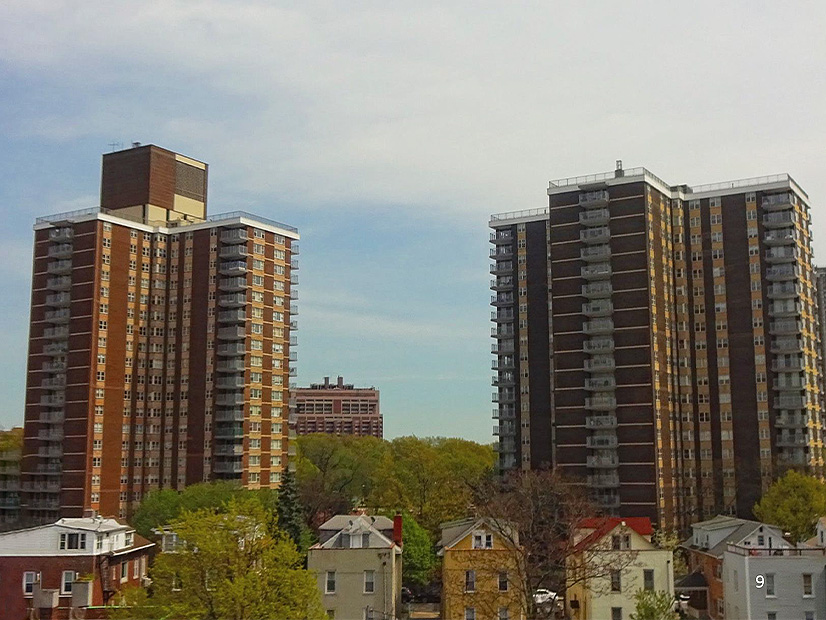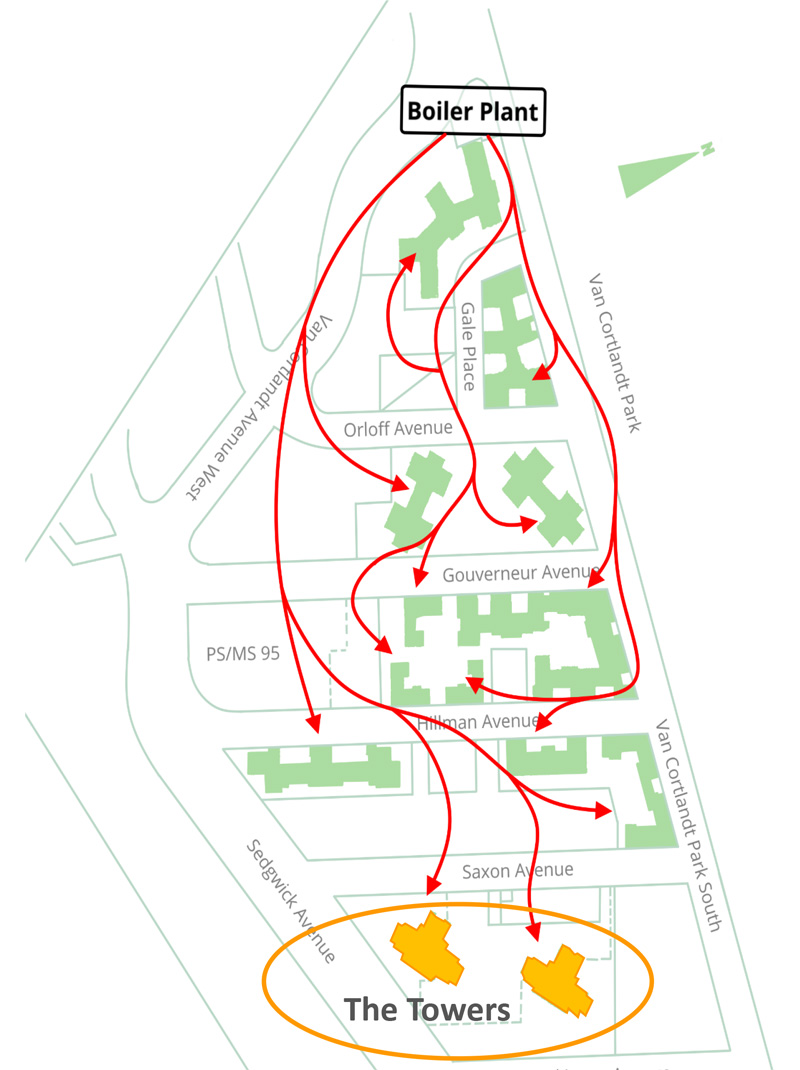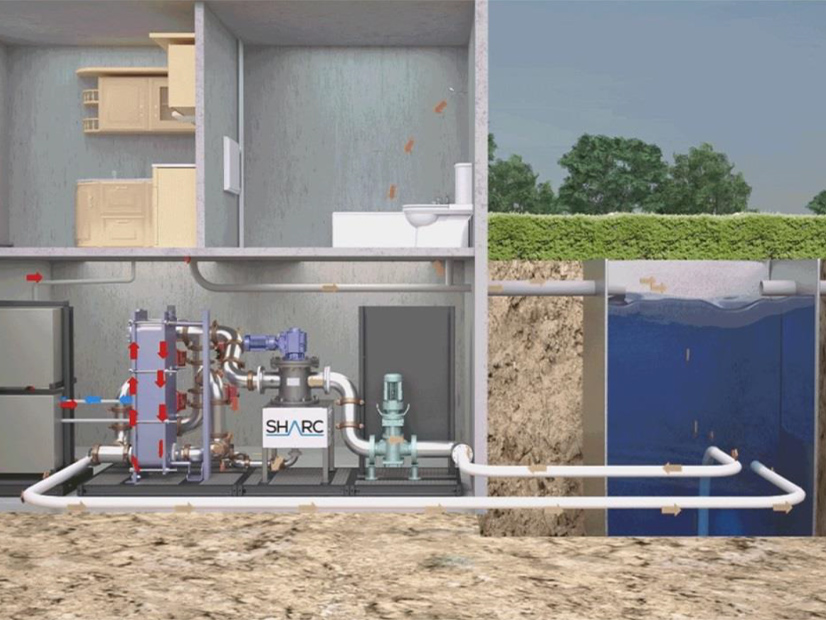
Canadian company SHARC Energy will build a combined wastewater energy transfer (WET) geothermal system for heat and water in two of Amalgamated Housing Cooperative’s (AHC) buildings in the Bronx as part of New York state’s Empire Building Challenge (EBC).
SHARC, AHC and geothermal energy company Egg Geo announced their plans last month to retrofit the two co-ops, collectively called “the Towers,” by installing their system, which uses heated wastewater from, for example, a building’s dishwashers, showers and laundry machines to bring energy, usable water and heat to tenants.
The partnership leverages some of the $50 million that was allocated by the New York State Energy Research and Development Authority (NYSERDA) through the EBC to improve building energy efficiency across the state with decarbonization systems. (See Empire Building Challenge Seeks to Decarbonize NY High-rises.)
So far, the EBC has selected 16 real estate partners, including AHC, who have sought to collectively decarbonize the more than 70,000 housing units they manage and develop a “Playbook” that other building owners can study to learn how they can make their assets more climate friendly.
Several of these partners have already made tangible commitments to decarbonize their building stock.
 Geographic representation of current heat & water generation system for Towers | Amalgamated Housing Corporation
Geographic representation of current heat & water generation system for Towers | Amalgamated Housing CorporationVornado plans to make its portfolio carbon neutral by 2030 through a combination of solutions, including upgrading façades with curtain walls of steel and glass, using steam to heat its buildings’ water with less energy input, and installing centralized air systems to better distribute air and keep buildings cooler.
Empire State Realty Trust (ESRT) has targeted 2035 to be carbon neutral by partially electrifying their heating, ventilation and air conditioning (HVAC) systems, installing large heat pumps in buildings, and replacing outdated systems during lease turnovers, which is already ongoing in the Empire State Building.
And Hudson Square Properties (HSP) plans to take a more phased approach where it retrofits buildings floor-by-floor since this avoids significant tenant disruption, allows for greater flexibility, and fewer budgetary concerns.
Buildings are one of the greatest barriers to New York’s climate and energy goals because they account for roughly 30% of the state’s total carbon emissions and much of the stock is decades old, meaning upgrades will be costly.
The Towers, located in the Bronx’s Van Cortlandt Village, together contain 372 units with an average of four people per apartment and extend 20 floors up. The first building was built in 1968 and the second in 1971. They currently depend on a far-away distribution boiler system based that uses steam for heating, cooling and hot water.
‘Indigenous Energy Supply’
 SHARC CEO Lynn Mueller | SHARC Energy
SHARC CEO Lynn Mueller | SHARC EnergyIn an interview with NetZero Insider, SHARC Energy CEO Lynn Mueller said the WET system being installed in the Towers taps into the building’s wastewater stream and uses a patented direct heat transfer system, which functions through a heat exchanger located directly within Egg’s geothermal heat pump, to domestically pre-heat incoming water for future usage within the building.
Mueller said the combined system will require about “45% less space” than similar systems, “reduce costs by a similar magnitude” and provide the Towers with their own “indigenous energy supply.”
“If you are throwing away $5, and I can reach back in there and get it back for just $1,” then the economics “just make sense,” Mueller said. The system uses the “ubiquitous” supply of wastewater to “continuously grab energy from the waste stream,” which tenants can reuse from “birth to death.”
Mueller claims that the Towers can reduce their annual estimated carbon emissions by 1,200 to 1,500 tons, which he said equates to offsetting nearly “750 cars a year.” The CEO believes that wastewater heat recovery systems, such as SHARC’s WET system or its smaller single-building Piranha system, will be everywhere in the future, as sewers are a city’s “common artery.”
Steve Beyers, an engineer, researcher and building energy heat expert at Cornell University, told NetZero that the “the concept of using heat from wastewater as a heat pump source/sink is not new, but the SHARC technology is arguably simpler and requires no compression cycle or refrigerants.”

The company’s technology “may well be unique in its packaging and market maturity,” as he had not seen anyone else “offering a similar packaged system.” But, he noted, Cornell once considered a similar technology for its dorms that was never implemented because of the “upfront costs and maintenance concerns.”
In a statement to NetZero Insider, a NYSERDA spokesperson said, “SHARC’s Piranha system offers the potential to achieve a high-performance heat pump system that also captures and reutilizes waste heat from the project site. Wastewater heat recovery could potentially be an important technology for building decarbonization. The state’s Empire Building Challenge program is supporting a feasibility analysis of this novel technology, and we look forward to reviewing the results of this work as we continue to identify new technologies that support the goals of the state’s Climate Leadership and Community Protection Act.”
“Amalgamated has been ambitious in their decarbonization efforts,” Egg Geo President Jay Egg said in a statement. “That, along with the vision and support from NYSERDA’s Empire Building Challenge to carryout technical feasibility, have brought together an incredible team that will guide this project through to a fully capable retrofit that will decarbonize and electrify the Amalgamated Towers in the Bronx.”


